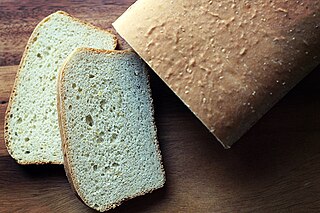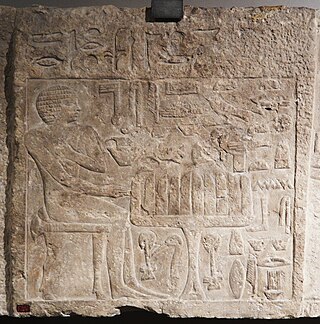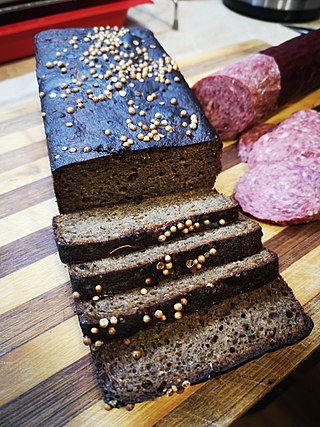Related Research Articles

Bread is a staple food prepared from a dough of flour and water, usually by baking. Throughout recorded history and around the world, it has been an important part of many cultures' diet. It is one of the oldest human-made foods, having been of significance since the dawn of agriculture, and plays an essential role in both religious rituals and secular culture.

Sourdough or sourdough bread is a bread made by the fermentation of dough using wild lactobacillaceae and yeast. Lactic acid from fermentation imparts a sour taste and improves keeping qualities.

Dough is a thick, malleable, sometimes elastic paste made from grains or from leguminous or chestnut crops. Dough is typically made by mixing flour with a small amount of water or other liquid and sometimes includes yeast or other leavening agents, as well as ingredients such as fats or flavorings.

Pumpernickel is a typically dense, slightly sweet rye bread traditionally made with sourdough starter and coarsely ground rye. It is sometimes made with a combination of rye flour and whole rye grains.

Rugbrød is a very common form of rye bread from Denmark. Rugbrød usually resembles a long brown extruded rectangle, no more than 12 cm high, and 30–35 cm wide, depending on the bread pan in which it is baked. The basic ingredient is rye flour which will produce a plain or "old-fashioned" bread of uniform, somewhat heavy structure, but the most popular versions today contain whole grains and often other seeds such as sunflower seeds, linseeds or pumpkin seeds. Most Danes eat rugbrød every day.

A bread making machine or breadmaker is a home appliance for baking bread. It consists of a bread pan, at the bottom of which are one or more built-in paddles, mounted in the center of a small special-purpose oven. The machine is usually controlled by a built-in computer using settings input via a control panel. Most bread machines have different cycles for different kinds of dough—including white bread, whole grain, European-style, and dough-only. Many also have a timer to allow the bread machine to function without operator input, and some high-end models allow the user to program a custom cycle.

Quick bread is any bread leavened with a chemical leavening agent rather than a biological one like yeast or sourdough starter. An advantage of quick breads is their ability to be prepared quickly and reliably, without requiring the time-consuming skilled labor and the climate control needed for traditional yeast breads.

Rye bread is a type of bread made with various proportions of flour from rye grain. It can be light or dark in color, depending on the type of flour used and the addition of coloring agents, and is typically denser than bread made from wheat flour. Compared to white bread, it is higher in fiber, darker in color, and stronger in flavor. The world's largest exporter of rye bread is Poland.
A ferment is a fermentation starter used in indirect methods of bread making. It may also be called mother dough.

Pain de campagne, also called "French sourdough", is typically a large round loaf ("miche") made from either natural leavening or baker's yeast. Most traditional versions of this bread are made with a combination of white flour with whole wheat flour and/or rye flour, water, leavening and salt. For centuries, French villages had communal ovens where the townsfolk would bring their dough to be baked, and the loaves weighed from 1.5 to 5.5 kilograms (3–12 lb). Such large loaves would feed a family for days or weeks, until the next baking day.

In cooking, proofing is a step in the preparation of yeast bread and other baked goods in which the dough is allowed to rest and rise a final time before baking. During this rest period, yeast ferments the dough and produces gases, thereby leavening the dough.

Vienna bread is a type of bread that is produced from a process developed in Vienna, Austria, in the 19th century. The Vienna process used high milling of Hungarian grain, and cereal press-yeast for leavening.

Salt-rising bread is a dense white bread that is traditional in the Appalachian Mountains, leavened by naturally occurring wild bacteria rather than by yeast. Salt-rising bread is made from wheat flour; a starter consisting of either water or milk and corn, potatoes or wheat; and minor ingredients such as salt and sugar.[1] Some common ways of eating salt-rising bread include a slice with sugared coffee poured over it, a grilled cheese sandwich, and the most popular preference, buttered toast.[1]
The sponge and dough method is a two-step bread making process: in the first step a sponge is made and allowed to ferment for a period of time, and in the second step the sponge is added to the final dough's ingredients, creating the total formula. In this usage, synonyms for sponge are yeast starter or yeast pre-ferment. In French baking the sponge and dough method is known as levain-levure. The method is reminiscent of the sourdough or levain methods; however, the sponge is made from all fresh ingredients prior to being used in the final dough.
Parāoa rēwena is a type of sourdough bread from New Zealand. The bread is leavened with a fermented potato starter that is commonly known as a bug. It originated amongst the Māori people and is closely associated with Māori cuisine. The bread is also known as Rēwena bread or Māori bread.

Bread was central to the formation of early human societies. From the Fertile Crescent, where wheat was domesticated, cultivation spread north and west, to Europe and North Africa, and east towards East Asia. This in turn led to the formation of towns, as opposed to the nomadic lifestyle and gave rise to more and more sophisticated forms of societal organization. Similar developments occurred in the Americas with maize and in Asia with rice.

Borodinsky bread or borodino bread is a dark brown sourdough rye bread of Russian origin, traditionally sweetened with molasses and flavored with coriander and caraway seeds.

Bread is a staple food throughout Europe. Throughout the 20th century, there was a huge increase in global production, mainly due to a rise in available, developed land throughout Europe, North America and Africa.
References
- ↑ Kandell, Jonathan (2006). "Desem Bread: A Primer and Love Letter" . Retrieved 26 July 2023.
- ↑ Robertson, Laurel. (2003). The Laurel's kitchen bread book : a guide to whole-grain breadmaking. Flinders, Carol., Godfrey, Bronwen. (Random House trade paperback ed.). New York: Random House. ISBN 0-8129-6967-7. OCLC 53031878.
- ↑ maki (2003-12-06). "Desem, Day 1". JustHungry. Retrieved 2019-11-24.
- ↑ "Desem -- I take it all back". The Fresh Loaf. Retrieved 2019-11-24.
- ↑ "Using a Desem Starter". SourdoughBaker. Retrieved 2019-11-24.
- ↑ maki (2003-12-14). "The Care and Feeding of Desem, Week 2". JustHungry. Retrieved 2019-11-24.,
- ↑ "Desem Starter". Whole Grain 100. Retrieved 2019-11-24.
- ↑ "How I do Desem… | Northwest Sourdough". 2007-03-17. Retrieved 2019-11-24.
- ↑ France (2018-01-29). "Girl Meets Rye : Desem: A Lost Bread". Girl Meets Rye. Retrieved 2019-11-24.
- ↑ "Desem Starter". Whole Grain 100. Retrieved 2019-11-24.
- Good Food: The Complete Guide to Eating Well, Margaret Wittenberg. 1995. p93.
- Downes, John, 1949- (1983). The natural tucker bread book. Melbourne: Hyland House. ISBN 0-908090-61-7. OCLC 152466788.
{{cite book}}: CS1 maint: multiple names: authors list (link) - The Laurel's Kitchen Bread Book: A Guide to Whole-Grain Breadmaking 2ed, Random House, 2003, ISBN 978-0-8129-6967-2.
